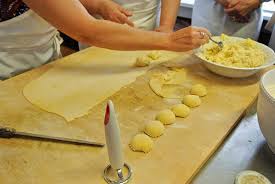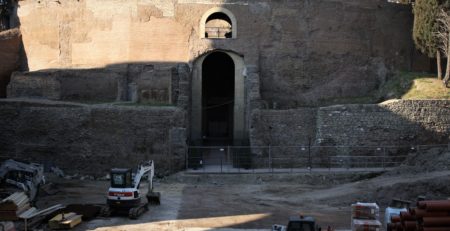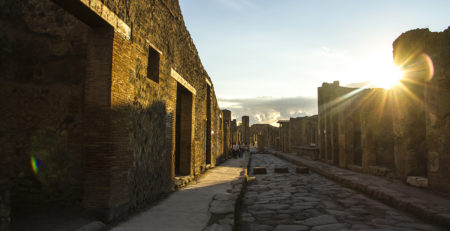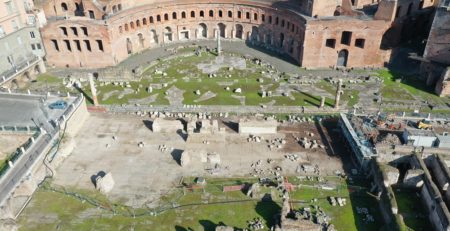Pasta
Did you know that there are more than 300 different types of pasta available in Italy, with many being called different names in different regions. Which means that what you are eating in Milan, may be called something else in a different town, whereas some types of pasta are uniquely regional and not widely known.
DIFFERENT TYPES OF PASTA
Different types of pasta are made to be eaten with different sauces and come in both dried and fresh varieties, that come in many different shapes. Long pasta. Short pasta. Tubes, flat shapes and sheets, as well as miniature soup shapes. It can be also be filled with meat, cheese or vegetables.
Pasta is classically used in one of three kinds of prepared dishes. As ‘pasta asciutta’ (or pastasciutta) cooked pasta is plated and served with a complementary sauce or condiment. ‘Pasta in brodo’, pasta served in broth, in which the pasta is part of a soup-type dish. A third category is ‘pasta al forno’, in which the pasta incorporated into a dish that is subsequently baked.
FRESH PASTA
Fresh pasta is usually made with a mixture of eggs and all-purpose flour or “00” low gluten flour. Because it contains eggs, it is more tender compared to dried pasta and only takes about half the time to cook. Delicate sauces are preferred for fresh pasta in order to let the pasta take front stage.
DRIED PASTA
Dried pasta can also be defined as factory-made pasta because it is usually produced in large amounts that require large machines with superior processing capabilities to manufacture.
Dried pasta needs to be dried at a low temperature for several days to evaporate all the moisture allowing it to be stored for a longer period. Dried pastas are best served in hearty dishes like ragu sauces, soups, and casseroles. The way to create the finest dried pasta is by mixing golden semolina flour, ground from durum wheat, with water. Good quality dried pasta is identified by its slight rough surface and compact body that helps maintain its firmness in cooking, since it swells considerably in size when cooked.
TYPICAL ROMAN PASTA DISHES
There are two types of pasta in Rome that aren’t as prevalent elsewhere, bucatini and tonnarelli. Bucatini (which translates to little hole) is long pasta, shaped like a straw, a little thicker than spaghetti but with a hole in the center. Tonnarelli is a thicker, more squared, version of spaghetti.
Bucatini all Amatriciana
Spaghetti alla Carbonara
Cacio e Pepe
Penne all Arrabbiata
Bucatini all’Amatriciana – After carbonara, this may be the next most popular pasta from Rome. It’s made with guanciale, pecorino Romano cheese, tomatoes, chili peppers (peperoncini), black pepper and a little wine. Purists will say that onions do not go in this dish, but many places add them. Guanciale is the key to this dish; and pancetta shouldn’t be substituted here.
Spaghetti alla Carbonara – Roman classic made with pecorino cheese, guanciale or pancetta, parmigiano cheese, black pepper and eggs. When the eggs and cheese hit the hot pasta they combine to make a creamy sauce that clings to each strand of spaghetti.
Cacio e Pepe A spicy version of the American mac and cheese. Two ingredients added to the pasta – pecorino and black pepper combine to make a creamy and peppery sauce.
Penne all’ Arrabbiata – Arrabbiata means angry, and this dish is called angry because it’s extra spicy. Very much like Amatriciana, made with tomatoes, chiLli peppers,guanciale and pecorino. This dish has less guanciale and more peppers than amatriciana.
ITALY’S BEST PASTA DICTIONARY:
Anelli
Small rings of pasta. It can be used in various soups and is also a complement to the fresh vegetables in a number of salads. Its smaller version, Anellini, can also be used in its place.
Bucatini
This straw-like pasta is shaped like thick Spaghetti but is hollow in the center. Bucatini is the perfect choice for nearly any sauce, or it can be baked in casseroles or stirfried in dishes. Try it with different lean proteins and sauces for a change of pace.
Campanelle
(“Bells”) Campanelle pasta resembles a small cone with a ruffled edge. Campanelle pasta can be paired with lean proteins, vegetables or sauces of any base. These shapes can also be a treat in a cold pasta salad.
Cappelletti
Cappelletti pasta is folded and then twisted to form the shape of a small hat. On occasion, this pasta is sometimes referred to as an alpine hat.
Cavatappi
(“Corkscrew”) The tight spiral locks-in the flavor, allowing the shape to pair with both simple and sophisticated sauces. Pair Cavatappi with sauces of any base or partner it with vegetables or lean protein and this pasta is sure to impress. Also, these shapes are great when used in pasta salads.
Cavatelli
Cavatelli resembles tiny hot dog buns. These shapes are commonly served with thick, chunky sauces or in pasta salads. Cavatelli pairs nicely with meat, cream, seafood or vegetable sauces.
Conchiglie (Shells in Small, Medium, and Large)
Shells make a great addition to soups or as the base of a wonderful salad. For a fun twist on a time-honored tradition, try remaking your favorite Macaroni and Cheese using Shells. Large Shells are best when stuffed with your favorite mixtures of cheese, meat and vegetables. Stuff with meat flavored with taco seasoning, top with salsa and bake for a delicious Mexican dish, or create your own stuffed treat.
Ditalini
(“Little Thimbles”) This versatile shape can be used as the base of any dish. Bake it, stir it into soups, or create great salads and stir-fry dishes.
Egg Noodles (Medium and Wide)
(From “Nudel,” German meaning paste with egg) – This size of Egg Noodle can be baked, tossed in soups or salads, or topped with cream, tomato, cheese or meat sauces. Go beyond the traditional Stroganoff and use Wide Egg Noodles to create soups, salads and casseroles. Or, top with a variety of sauces.
Farfalle (Bow Ties)
(“Butterflies”) Bow Ties brighten any meal with their interesting shape. Thick enough for a variety of sauces, or a perfect addition to a number of salad or soup recipes.
Fusilli
(“Twisted Spaghetti”) This long, spiraled shape can be topped with any sauce, broken in half and added to soups, or turned into a beautiful salad. Fusilli also bakes well in casseroles.
Farfalline
Farfalline is a small version of the bow tie or butterfly shaped pasta. This versatile shape can be used as the base of any dish. Bake it, stir it into soups, or create great salads and stir-fry dishes.
Gemelli
(“Twins”) Add a touch of style to any dish with this distinctive shape. Gemeilli pairs nicely with meat, cream, seafood and vegetable sauces.
Gigli
(“Lilies”) Gigli is a fluted edge piece of pasta that has been rolled into a coneshaped flower. Gigli is perfect for heavier sauces, like cheese, meat and tomato or it is a perfect addition to a number of casseroles.
Lasagna
(From “lasanum,” Latin for pot) Create original Lasagna casseroles by using chopped vegetables, cheeses and any kind of sauce. You can also assemble your casserole and freeze it for a later meal.
Linguine
(“Little Tongues”) A great shape to complement a variety of sauces. Also a good choice for salads and stir-fry dishes.
Macaroni
A highly versatile shape that can be topped with any sauce, baked, or put in soups, salads and stir-fry dishes. Elbow Macaroni is traditionally used to make Macaroni and Cheese, but why not change it up and add in some seasonings, proteins, or veggies for a delightful dish.
Manicotti
(“Small Muffs”) Stuff Manicotti with a mixture of meat, cheese and vegetables, top with your favorite sauce, and bake.
Orecchiette
(“Little Ears”) These “little ears” are commonly served with thick, chunky sauces or in pasta salads.
Penne
(“Quills” or “Feathers”) Penne complement virtually every sauce and are exceptional when paired with a chunky sauce. Penne pairs nicely with chunky meat, chunky vegetable, cream, or oil based sauces. Also, these shapes are great for baking dishes.
Penne Mostaccioli
(“Quills” and “Small Mustaches”) This tubular pasta complements a variety of sauces, is frequently used in salads, baked in casseroles, or made into stirfry dishes.
Pipe Rigate
A hollow curved pasta that resembles a snail shell. This shape has a wide opening at one end and the other end is flattened. Pipe Rigate pairs nicely with chunky meat, chunky vegetable, cream, or oilbased sauces.
Rigatoni
(“Large Grooved”) Rigatoni’s ridges and holes are perfect with any sauce, from cream or cheese to the chunkiest meat sauces.
Ravioli
Ravioli are square round pillows of pasta that have a filling consisting of ingredients such as cheese, meats, vegetables and seasonings. Ravioli can be served with a red sauce or it can be served with butter, oil or cream.
Tortiglioni
Tortiglioni is narrow, tubular pasta. This shape is commonly used to add decoration to salads or paired with a simple sauce.
Ruote (Wagon Wheels)
(“Wheels”) Wagon Wheels make interesting salads, casseroles and stir-fry dishes. Add to soups, or simply top with sauce and enjoy
Spaghetti
(“A length of cord”) America’s favorite shape, Spaghetti is the perfect choice for nearly any sauce, or it can be used to make casseroles or stir-fry dishes. Go beyond tomato sauce and see what your favorite becomes.
Tortellini
Tortellini is a ring-shaped pasta typically stuffed with meat, cheese or vegetables. Tortellini is commonly served in a broth or cream sauce.
What’s your favourite type of Italian pasta?
Why not book our mouth watering Food Tour to discover more about Italian cuisine.
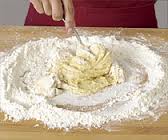 Booking and more details: info@italysbestrome.com
Booking and more details: info@italysbestrome.com








